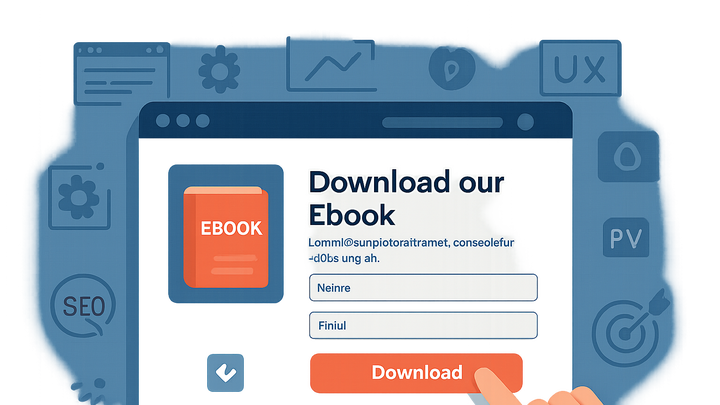Published on 2025-06-29T19:19:34Z
What is a Lead Magnet? Examples & Best Practices
A lead magnet is a marketing tool that offers a valuable resource—such as an e-book, checklist, or free trial—in exchange for a visitor’s contact information, typically their email address. It plays a crucial role in Conversion Rate Optimization (CRO) and user experience (UX) by providing immediate value, building trust, and guiding prospects through the sales funnel.
In SEO, well-crafted lead magnets can reduce bounce rates and increase dwell time, signaling relevance and authority to search engines. When optimizing a website with tools like Prevue.me, a robust lead magnet strategy can significantly boost both lead generation and overall site performance.
Ensuring your lead magnets are accessible, mobile-friendly, and aligned with user intent maximizes engagement and conversion.
Lead magnet
A focused incentive offered to users in exchange for contact info, boosting lead generation through CRO, UX, and SEO benefits.
Importance of Lead Magnets in CRO, UX, and SEO
Lead magnets are central to driving conversions by delivering immediate value and encouraging users to engage with your site. They support UX by addressing user needs and boost SEO metrics through reduced bounce rates and increased session durations.
-
Boosting conversion rates
Lead magnets entice visitors to take action by offering targeted value propositions.
- Relevance:
Ensure the lead magnet closely matches the user’s intent and pain points.
- Value perception:
Clearly communicate benefits to maximize appeal.
- Relevance:
-
Enhancing user experience
Well-designed lead magnets improve UX by offering clear, immediate solutions.
- Clarity:
Use straightforward language and design to reduce friction.
- Accessibility:
Provide formats compliant with accessibility standards (e.g., screen-reader friendly PDFs).
- Clarity:
-
Seo benefits
Quality lead magnets can lower bounce rates and lengthen dwell time, improving SEO signals.
- Content depth:
In-depth resources increase on-page engagement and can be repurposed for blog content.
- Internal linking:
Link to lead magnets from relevant site content to guide users deeper.
- Content depth:
Common Types of Lead Magnets
Popular lead magnets take various shapes to meet diverse audience needs while delivering high perceived value.
-
Ebooks and guides
Comprehensive written resources exploring topics in depth.
- Format:
Typically delivered as downloadable PDFs or interactive web pages.
- Example:
An SEO step-by-step guide for small businesses.
- Format:
-
Checklists and cheat sheets
Concise, actionable lists that simplify complex tasks.
- Use case:
Quick-reference on-page SEO checklist for content creators.
- Use case:
-
Webinars and video tutorials
Live or recorded sessions offering expert insights and demonstrations.
- Engagement:
Interactive Q&A segments boost participation.
- Engagement:
-
Free tools and templates
Ready-to-use assets that streamline workflows.
- Example:
Content calendar template for marketing teams.
- Example:
-
Free trials and demos
Hands-on experience with a product or service.
- Platform example:
prevue.me 7-day trial with actionable CRO, UX, SEO, and accessibility critique.
- Platform example:
Best Practices for Designing Effective Lead Magnets
Optimizing your lead magnets involves aligning with audience needs, crafting compelling calls to action, and ensuring seamless delivery.
-
Align with audience needs
Use data-driven insights to tailor lead magnet topics and formats.
- Surveys & feedback:
Leverage tools like prevue.me’s UX critique to validate assumptions.
- Surveys & feedback:
-
Craft compelling calls to action
Use clear, action-oriented language and strategic placement to drive clicks.
- Placement:
Test CTAs above the fold, within content, and in exit-intent popups.
- Placement:
-
Optimize landing pages
Keep forms minimal, include trust signals, and use persuasive copy.
- A/b testing:
Run experiments with prevue.me to refine page elements and layouts.
- A/b testing:
-
Ensure accessibility and mobile-friendliness
Design for all users and devices to maximize reach and compliance.
- Responsive design:
Verify forms and content adapt smoothly to different screen sizes.
- Responsive design:
Measuring Success and Iterative Improvement
Tracking key metrics and continuously refining your lead magnets ensures sustained performance gains.
-
Key metrics to track
Monitor conversion rates, click-through rates, bounce rates, and email engagement to gauge effectiveness.
- Benchmarking:
Compare results against industry averages to set realistic targets.
- Benchmarking:
-
Tools for optimization
Employ SaaS tools to identify areas for improvement and validate changes.
- Example workflow:
Use prevue.me to generate critiques, implement recommendations, and retest.
- Example workflow:
-
Iterative testing
Continuously run A/B tests and collect user feedback for data-driven enhancements.
- Feedback loops:
Incorporate post-download surveys to gather additional insights.
- Feedback loops:
